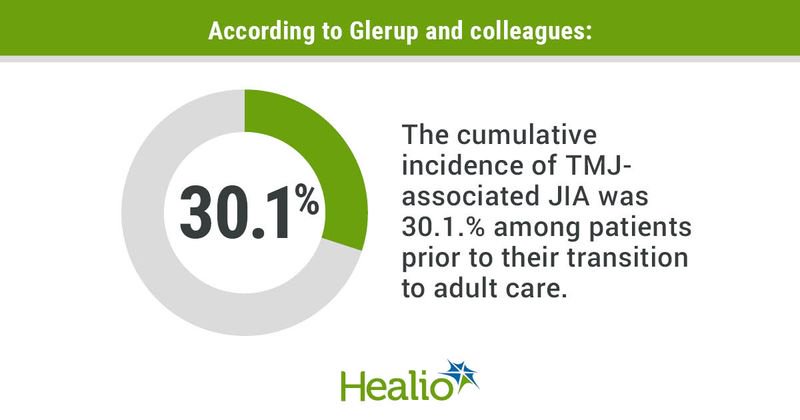TMJ involvement, dentofacial deformity ‘frequent complications’ of juvenile arthritis
Key takeaways:
- Orofacial signs and symptoms are frequent in children with juvenile idiopathic arthritis.
- Factors that were associated with TMJ-involved disease at baseline included JIA onset at younger than 9 years of age, female sex and antinuclear antibody positivity.
Approximately 30% of patients with juvenile idiopathic arthritis develop temporomandibular joint involvement before transitioning to adult care, according to data published in Arthritis & Rheumatology.
Meanwhile, nearly 21% of the JIA cohort demonstrated JIA-related dentofacial deformity prior to adult care, the researchers added.

“The past decade has seen growing attention to orofacial manifestations related to juvenile idiopathic arthritis (JIA),” Mia Glerup, MD, PhD, of the pediatric rheumatology clinic at Aarhus University, in Denmark, and colleagues wrote. “These orofacial manifestations of JIA may profoundly affect the subject’s general quality of life.”
To investigate the incidence of temporomandibular joint (TMJ)-involved orofacial conditions in patients with JIA, Glerup and colleagues conducted a population-based cohort analysis. The researchers extracted data from the Aarhus JIA TMJ cohort database from January 2000 to May 2018. Patients were included in the analysis if they had received a diagnosis of JIA, underwent their first orofacial examination after the year 2000 and were aged 16 years or older at the censoring date of May 1, 2018. Data were collected from the facility that referred the patient to the database.
Analyzed data included the age of patients at the time of diagnosis, the category of JIA, the number of active joints at baseline, laboratory results, rheumatoid factor and medications. In addition, Glerup and colleagues included progress information and the dates of consultations for orofacial conditions. They also included information regarding orofacial symptoms and dentofacial dysfunction.
A total of 613 patients were included in the analysis. From the onset of JIA through transition into adult care, there was a cumulative incidence of TMJ-associated JIA of 30.1.%. In addition, there was a 20.6% incidence of arthritis-induced dentofacial deformity in the cohort, according to the researchers. Factors that were associated with TMJ-involved disease at baseline included JIA onset at younger than 9 years of age, female sex and antinuclear antibody positivity.
“The present study investigating orofacial manifestations of JIA is the first population-based study using real-world data in the biologic era to report on the cumulative incidence of orofacial manifestations of JIA,” Glerup and colleagues wrote. “Our study documented that 30 percent of the total JIA cohort developed TMJ involvement before transition into adult care.
“Moreover, 20.6% of the entire cohort developed JIA-induced dentofacial deformity beyond normal variation, requiring non-surgical orthopedic treatment,” they added. “The results elucidate that TMJ involvement and JIA-related dentofacial deformity are frequent complications to which future research, JIA treatment, and health care programs should devote particular attention.”

